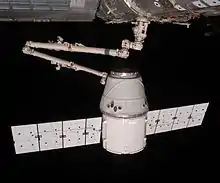NASA Docking System
The NASA Docking System (NDS) is a spacecraft docking and berthing mechanism being developed for future US human spaceflight vehicles, such as the Orion spacecraft and the Commercial Crew vehicles. The NDS is NASA's implementation of the International Docking System Standard (IDSS), an attempt by the International Space Station Multilateral Coordination Board (MCB) to create an international spacecraft docking standard. The international Low Impact Docking System (iLIDS)[1] is the precursor to the NDS. The NDS Block 1, was designed and built by The Boeing Company in Houston TX, to meet the IDSS standards. Design qualification testing took place through January 2017.
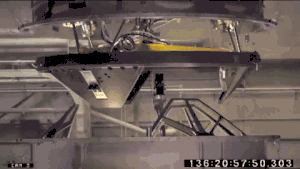
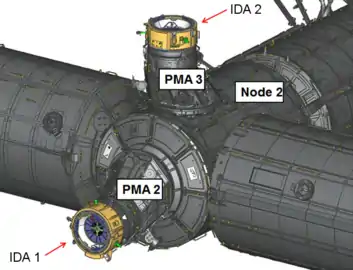
NASA has developed the International Docking Adapter in order to convert the older APAS-95 docking system used on ISS Pressurized Mating Adapters to the NASA Docking System. The first IDA, IDA-1 was originally scheduled to be attached to PMA-2, located on the forward hatch on Node 2, and IDA-2 was to be attached to PMA-3, on the zenith hatch on Node 2. IDA-2 was rescheduled to be attached to PMA-2 after IDA-1 was destroyed. It was delivered successfully on SpaceX's CRS-9 mission in July 2016, and then installed on PMA-2 in August of that year during a spacewalk as part of Expedition 48.[2] IDA-3 started construction after IDA-1 was destroyed, and was made mainly from spare parts in order to speed up its construction.[3] IDA-3 was delivered on SpaceX CRS-18 on July 25, 2019, and was installed a month later on August 21st by NASA astronauts Nick Hague and Andrew Morgan as part of Expedition 60.
Design
The NDS docking mechanism is androgynous, the first system to use low impact technology and the first system to allow both docking and berthing.[4] It supports both autonomous and piloted dockings and features pyrotechnics for contingency undocking. Once mated the NDS interface can transfer power, data, commands, air, communication and in future implementations will be able to transfer water, fuel, oxidizer and pressurant as well.[1] The passage for crew and cargo transfer has a diameter of 800 millimetres (31 in).[5]
In form and function NDS resembles the Shuttle/Soyuz APAS-95 mechanism already in use for the docking ports and pressurized mating adapters on the International Space Station. There is no compatibility with the larger common berthing mechanism used on the US segment of the ISS, the Japanese H-II Transfer Vehicle, SpaceX Dragon, and Orbital Sciences' Cygnus spacecraft.
History
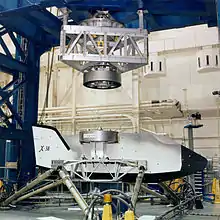
In 1996, Johnson Space Center (JSC) began development of the Advanced Docking Berthing System,[6] which would later be called the X-38 Low-Impact Docking System.[7][8] After the X-38 was canceled in 2002, development of the mating system continued, but its future was unknown.[6] In 2004, President George W. Bush announced his Vision for Space Exploration and NASA's 2005 Exploration Systems Architecture Study was created in response, recommended the use of the Low Impact Docking System (LIDS) for the Crew Exploration Vehicle (which was later named Orion) and all applicable future exploration elements.[9]
The Hubble Space Telescope received the Soft-Capture Mechanism (SCM) on STS-125.[10] The SCM is meant for unpressurized docking, but uses the LIDS interface to reserve the possibility of an Orion docked mission.[10] The docking ring is mounted on Hubble's aft bulkhead.[10] It may be used for safely de-orbiting Hubble at the end of its service lifetime.[10]
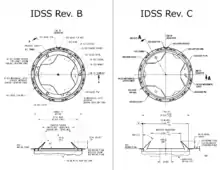
In February 2010, the LIDS program became modified to be compliant with the IDSS and became known as the international Low Impact Docking System (iLIDS) or simply the NASA Docking System (NDS).[4] In May 2011, the NDS critical design review was completed and qualification was expected to be completed by late 2013.[11]
In April 2012, NASA funded a study to determine if a less complex docking system could be used as the NASA Docking System that both met the international community's desire for a narrower soft capture system ring width, as well as providing the ISS a simpler active docking system compared to the then-planned design.[12] Boeing's proposal was the Soft Impact Mating and Attenuation Concept (SIMAC), a design originally conceived in 2003 for the Orbital Space Plane (OSP) Program.[12]
A leaked NASA internal memo from November 2012, stated that SIMAC had been chosen to replace the previous design and that the majority of the work on the NASA Docking System would be shifted from NASA JSC to Boeing.[13] In August 2014, Boeing announced that the critical design review for the redesigned NDS had been completed.[14] Following this change the IDSS was modified (to rev D), so the new design of the NASA Docking System is still compatible with the standard.[12][5][14]
IDA-1 was part of the payload on SpaceX CRS-7 in June 2015, but was destroyed when the Falcon 9 rocket exploded during ascent.[15]
IDA-2 was launched on SpaceX CRS-9.[16] and was installed to the ISS's second Pressurized Mating Adapter (PMA-2) on 19 August 2016.[17] Crew Dragon Demo-1 was the first spacecraft to dock at this port on 2 March 2019.
IDA-3 was launched on the SpaceX CRS-18 mission in July 2019.[18] IDA-3 is constructed mostly from spare parts to speed construction.[19] It was attached and connected to PMA-3 during a spacewalk on 21 August 2019. [20]
References
- Parma, George (2011-05-20). "Overview of the NASA Docking System and the International Docking System Standard" (PDF). NASA. Archived from the original (PDF) on 15 October 2011. Retrieved 11 April 2012.
- https://www.spaceflightinsider.com/missions/iss/new-front-porch-added-international-space-station/
- Clark, Stephen. "Boeing borrows from inventory to speed docking adapter delivery – Spaceflight Now".
- (PDF). February 15, 2013 https://web.archive.org/web/20130215180627/http://dockingstandard.nasa.gov/Meetings/TIM_(Nov-17-2010)/NDS_TIM_presentation.pdf. Archived from the original (PDF) on February 15, 2013. Missing or empty
|title=(help) - "International Docking System Standard (IDSS) Interface Definitions Document (IDD) Revision D April 2015" (PDF). International Docking System Standard. ISS Multilateral Control Board. Retrieved October 31, 2015.
- Low Impact Docking System (2009-02)
- Advanced Docking/Berthing System - NASA Seal Workshop (2004-11-04) Archived 2011-09-22 at the Wayback Machine
- Advanced Docking Berthing System Archived 2009-02-26 at the Wayback Machine
- Wilson, Jim. "NASA - NASA's Exploration Systems Architecture Study -- Final Report". www.nasa.gov.
- NASA (2008). "The Soft Capture and Rendezvous System". NASA. Retrieved May 22, 2009.
- Bayt, Rob (2011-07-26). "Commercial Crew Program: Key Driving Requirements Walkthrough". NASA. Archived from the original on 28 March 2012. Retrieved 27 July 2011.
- Pejmun Motaghedi and Siamak Ghofranian. "Feasibility of the SIMAC for the NASA Docking System" (PDF). Boeing. Retrieved 27 September 2014.
- Johnson Space Center (2012-11-13). "NASA Decides to Adopt Boeing SIMAC Design for Docking and Is Retiring the iLIDS Design". SpaceRef. Retrieved 15 November 2012.
- "Boeing Continues Progress on Improved Space Station Docking System". Boeing. 28 August 2014. Retrieved 28 September 2014.
- Graham, William (27 June 2015). "SpaceX's Falcon 9 fails during launch following second stage failure". nasaspaceflight.com. Retrieved 27 June 2015.
- Siceloff, Steven. "More than Two Tons of New Equipment Bound for Station Following Blazing Liftoff". NASA. Retrieved 20 July 2016.
- Grush, Loren (20 Aug 2016). "With the installation of the International Docking Adapter, the ISS is ready for the private spaceflight era". Retrieved 19 Mar 2019.
- Pietrobon, Steven (August 20, 2018). "United States Commercial ELV Launch Manifest". Retrieved August 21, 2018.
- Stephen Clark (1 May 2016). "Boeing borrows from inventory to speed docking adapter delivery". Spaceflight Now.
- "Spacewalkers Complete Installation of Second Commercial Docking Port – Space Station". blogs.nasa.gov.
- James L. Lewis, Advanced Docking Berthing System. NASA technical publication. Johnson Space Center.
- James L. Lewis, Monty B. Carroll. Prototype Low Impact Docking System. NASA technical publication. Johnson Space Center.
External links
- International Docking System Standard (IDSS) Interface Definitions Document (IDD) Revision D April 2015

